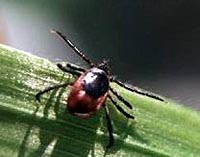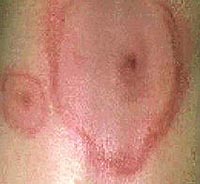In our article we are discussing the main questions about Lyme disease. What to do? Where to turn? How dangerous is the disease?
Content
Question number 1.What is lime borreliosis?
Lime Burrelioz is an infectious disease caused by microbes called Borrelia Burgdorferi, which are transmitted to a person when bite by ticks of some species. The disease has several stages and affects various organs and systems at different stages. In most cases, antibiotic treatment at an early stage of the disease is highly efficient, although the improvement can occur not quickly, within a few weeks or months.
Question # 2. Where and how can I get infected by Lym Burreliosis?
Infection occurs when the tick is bite infected with the microbe. The probability of infected with a bite depends on what percentage of ticks living in the territory where bite was infected. Pretty high (more than 5%) probability to infect exist on the so-called «Endemic» territories where many ticks are transferred to the microbe.
In Russia, such endemic territories include forests of the Leningrad, Tver, Yaroslavl, Kostroma, Kaliningrad, Perm, Tyumen regions. In the Urals, in Western Siberia and the Far East, borroeliosis bears are found in pastures. Infection is possible in the cities of these territories. Sometimes, the tick can get to the house with pets (cats and dogs) and move them to a person.
Question number 3. How to prevent the disease?
The most efficient way to prevent the disease is to prevent the tick bite. For this:
- When walking in places of potential habitat of ticks, use clothing with long sleeves and pants that are refined in socks;
- Use repellent (means to scare insects), are the most effective means containing from 10 to 35% N, N-diethyl-3-methylbenzamide (DETA). At a concentration of 25%, protection provides for 5 hours (children cannot be used with concentrations above 30%);
- Carefully inspect all the skin on the presence of a tick when returning from a walk;
- Take a shower with a washcloth after a walk, which will remove unnoticed ticks.
Question number 4. What to do if on the body you discovered a sucking tick?
 Extremely removal of the tick is very important to prevent Limin Borreliosis. The probability of getting sick if the tick spent on the body less than 24 hours, minimal. Various methods of removal of a sucking tick are investigated, but the most efficient and safe is the use of tweezers.
Extremely removal of the tick is very important to prevent Limin Borreliosis. The probability of getting sick if the tick spent on the body less than 24 hours, minimal. Various methods of removal of a sucking tick are investigated, but the most efficient and safe is the use of tweezers.
Before removing the tick, the skin should be processed by any antiseptic. It is necessary to capture the tong of tweezers (with stupid or rounded ends) as close as possible to the skin and remove it with a moderate uniform force, directed strictly vertically, without applying any unscrewing movements.
After removing the skin re-process the antiseptic. It is important to try during the extraction not to crush the tick. It is possible that small fragments of the mouth of the tick will remain in the rod - you should not try to extract them, they do not represent dangers, especially if the antiseptic is processed, and come out themselves.
If there is no tweezers at hand, you can remove the tick with a protected fingers (you can protect the bandage, rubber gloves). Ticks should be wrapped once a bandage, grasp as close to the skin and gently pull up perpendicular to the skin. After removing the tick, it is necessary to wash your hands with soap or to handle the antiseptic.
Important: Do not use chemical and physical methods, such as ointments, creams, oils, alcohol, nail polish, hot bonds and t.NS. There are assumptions that some of these methods can increase the risk of infection, as they increase the branch of infected saliva by tick. But the main argument is against - these methods increase the time of finding a sucking tick on the skin, and, therefore, contribute to raising the risk of infection by Lime Burreliosis.
Question number 5. Do I need prevention by antibiotics after removing a sucking tick?
 If the bite of the tick happened beyond its conventional habitat (see. Question №2), antibioticophylaxis is not needed.
If the bite of the tick happened beyond its conventional habitat (see. Question №2), antibioticophylaxis is not needed.- If the tick was on the skin (fed) less than 24 hours - the antibioticophylaxis is not needed. It has been proven that even if the infected tick fed to less than 24 hours, the likelihood of lime borreliosis is equal to 0.
- If the tick was on the skin (fastened) more than 72 hours, or the duration of its power is unknown, or the tick disappeared after saturation - the antibiotic pyrofilaxy should be carried out.
- If the tick was on the skin (fed) from 24 to 72 hours - the question of the need for antibiotic-porphylaxis is solved individually, for example, if an analysis of the tick is made and it is infected with borrelia, then the need for antibiotic popilaxis, t.To. Through 36-48 hours, borreli in place of bite and infection may be theoretically.
Important: The time before the start of reception of the antibiotic should be not more than 72 hours after the tick is removed. If more than 72 hours passed - the antibioticoprophylaxis is not shown, t.To. no evidence of its effectiveness.
For the antibiotic popilaxis, adults are recommended doxycycline 200 mg - one-time reception. For children over 8 years old, the dose is 4 mg / kg of body weight to the maximum 200 mg.
This is the only drug whose effectiveness is proved in a clinical trial. The effectiveness of other antibiotics for the prevention of Lime Burreliosis in clinical trials is not proven, but it is assumed on the basis of clinical observations.
Important: Doxycycline can not be used in pregnant women, lactating women and in children under 8 years.
Although there are no convincing evidence of effectiveness, it is reasonable to conduct antibiotic pregnancy to pregnant and nursing women (but not doxycycline) if the conditions for its purpose are satisfied. The decision to accept the observing doctor. Amoxicillin is most often used.
Question number 6. Do you need to keep track of any symptoms later?
Regardless of whether you turned to a doctor after the bite of a tick or not, it is necessary to observe the seat of the bite on the subject of the spread of redness, which can serve as a symptom of Lime Burreliosis. As a rule, this symptom («Migrating Erythema») develops during the first month after the tick bite. When such a symptom appears, immediately consult a doctor.
Components of saliva ticks can cause redness of the skin that passes for 2 days and is not migrating erythema.
Question number 7. Is it necessary to be examined on lime borreliosis, if there are no symptoms?
No, serological study (the detection of antibodies to borreliam in the blood) can only confirm the diagnosis under the existing clinical picture, but only according to the results of serological examination, the diagnosis is not exhibited. It should be known that in the study of blood on antibodies to borreliam, false positive results often occur.
Question number 8. During the examination, antibodies were detected to Borreliam - it means that I was infected (a) and will develop Limin Burreliosis?
No. Standard study on antibodies to borreliam is performed by the IFA method (enzyme immuno-analysis) or IFL (immunofluorescence). This method often gives false-positive results and in all cases when an antibody detected by IFA or IFL methods requires confirmation by immunoblot method. If antibodies are not detected in immunoblot, the first analysis is considered false and infected is not confirmed.
The likelihood that in a person without symptoms after the bite of an infected tick will be really detected by antibodies to borrelia, testifying to infection, is very small and amounts to no more than 5-7%.
Question number 9. It is necessary to carry out prophylactic treatment with antibiotics, if there are no symptoms, and antibodies to borreliam are really discovered?
There is no evidence that the preventive purpose of antibiotics in such persons prevents the development of Limin Burreliosis. Regular observation is required for a month for timely detection of early symptoms of Lime Burreliosis, treatment is carried out if such symptoms appear.
Question number 10. Are there any vaccine from Lime Burreliosis?
Such a vaccine was developed and applied in the United States until 2002, but then its release was discontinued, mainly for commercial reasons. The following generation vaccines are underway in Europe, but no vaccine allowed no vaccine.









